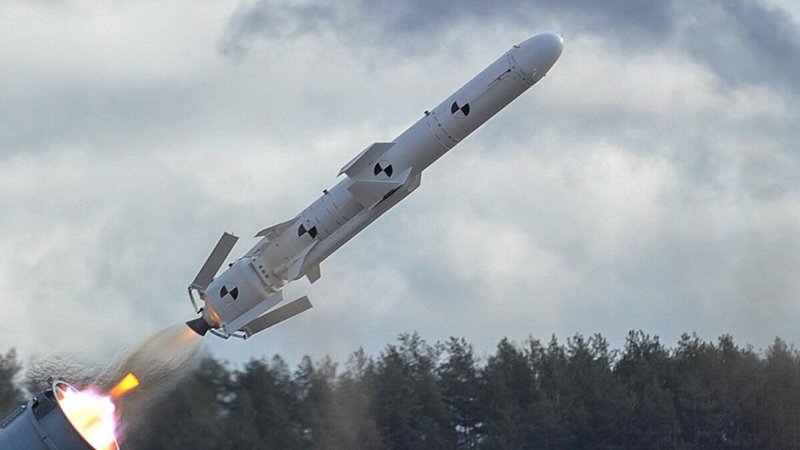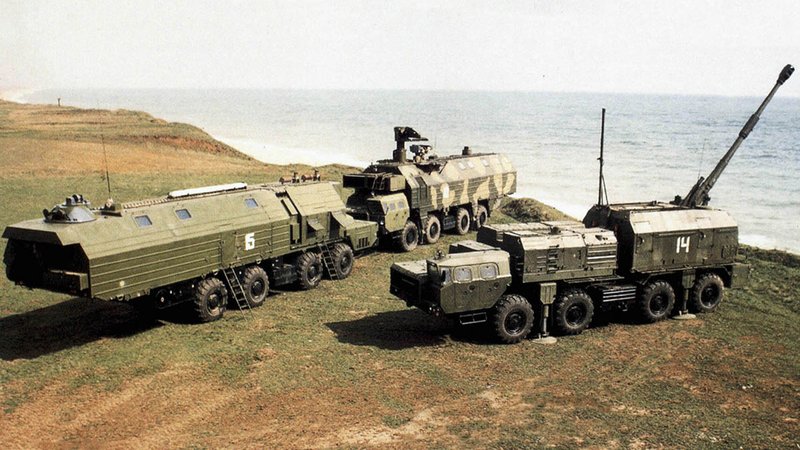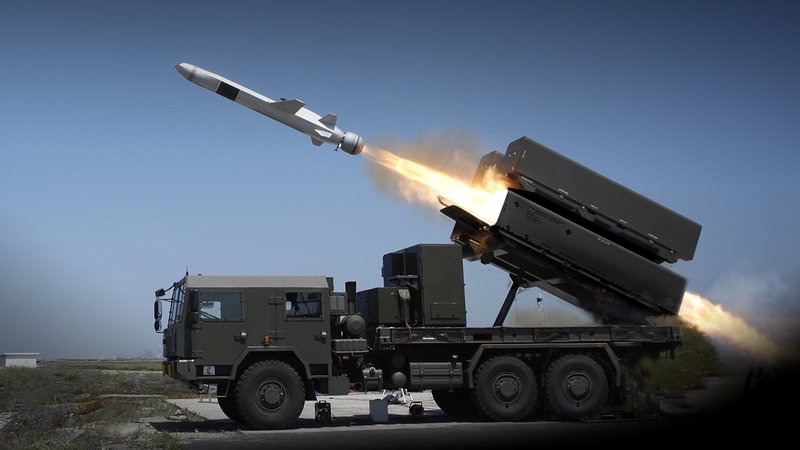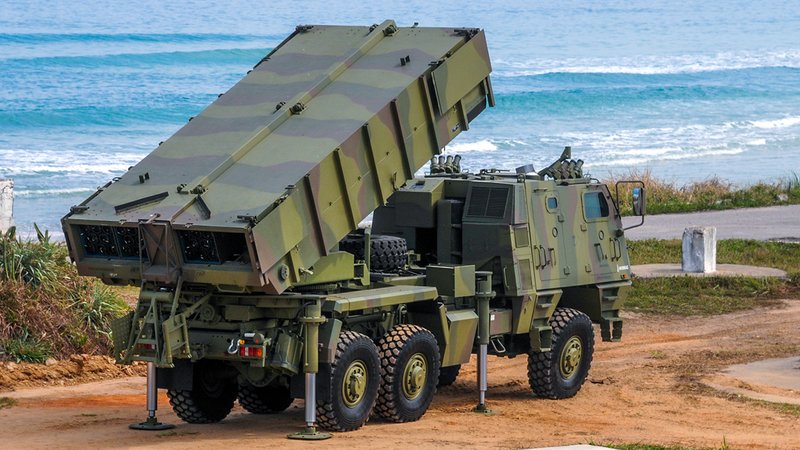Securing the shoreline – why coastal defence is back on the agenda
Events such as the sinking of the Russian cruiser Moskva by Ukraine in April 2022 using a Neptune missile system have highlighted the increasing emphasis placed on coastal defence by several countries, especially in Europe.
In most Western countries coastal artillery disappeared many years ago (in the 1950s in the UK and US) but Nordic nations such as Denmark, Norway, Finland and Sweden maintained their defences until the end of the Cold War... Continues below
Newsletter Sponsors:

Above: A Ukrainian R-360 Neptune anti-ship missile just after launch, showing the booster which falls away after the main turbojet engine cuts in. (Photo: Ukrainian MoD)
These were a mix of static turret guns such as the 120mm Bofors ERSTA deployed by Norway and Sweden, mobile artillery and missiles.
But today an increasing number of countries are looking at expanding their coastal long-range fires capability, mainly with highly mobile surface-to-surface missiles.
Given its success in combat, Ukraine’s R-360 Neptune system can be seen as an exemplar of this technology. The missile, which can also be air-launched, was developed by the Luch design bureau.
According to the prime contractor, a typical Neptune coastal defence battery would consist of a mobile command post, 48 missiles, four self-propelled launchers each with four rounds, four loading vehicles, four transport vehicles and a set of ground support equipment.
All units are based on an 8x8 or 6x6 wheeled platform for strategic mobility, with claimed maximum road speeds of 70km/h.

Explore armored vehicles and turret systems of Otokar, the global land systems manufacturer.
The 420mm diameter solid propellant missile has a maximum firing range of 300km and uses a nose-mounted active radar seeker with up to eight waypoints to make detection more difficult.
Soon after the missile leaves the launcher the booster falls away and the main engine cuts in; in the terminal phase the missile is only three to ten metres above the waves.
Launchers can be located up to 25km from the coast with targets detected by air (including UAVs), satellites and land- or sea-based radar.
The number of missiles launched depends on the target, with two hitting the Moskva, inflicting heavy damage that caused it to later sink whilst under tow.
The four launchers can fire a salvo of 16 missiles at the same time against well-defended targets to overcome the ship’s countermeasures, with the interval between salvoes being three to five seconds.
Once the fire mission is complete, the launchers and associated vehicles would move to be reloaded and avoid detection.
On top of this domestic capability, the US also recently agreed to supply Ukraine with two batteries of Boeing Harpoon missiles for the coastal defence role.
This US system is also finding favour in another potential flashpoint, Taiwan, with the US approving the sale to Taipei of a coastal defence system based on the latest Harpoon model which includes 100 launchers, 400 Block II missiles and training equipment.
In Turkey, Roketsan has developed the Atmaca anti-ship missile as a replacement for the country’s US-supplied Harpoons and a coastal defence vehicle model is being marketed. Atmaca has a range of at least 220km with a 220kg warhead.

China meanwhile has developed a gun-based technology for this role, with NORINCO marketing a ‘155mm Coast Defence Weapon System’ typically consisting of three batteries each with six 45 or 52cal towed howitzers and supporting radar, command and observation posts.
Maximum range depends on the projectile and charge but firing an extended-range full-bore – base bleed (ERFB-BB) rocket-assisted projectile from a 52cal system is effective at up to 51km. In addition laser-guided artillery rounds can be used for precision effect.
Back in Europe, Spain offers an equivalent with a version of the General Dynamics European Land Systems-Santa Barbara Sistemas 155mm 155/52 APU SBT howitzer optimised for the coastal defence mission, and coupled to a command post and associated radar.
When firing a standard M107 HE projectile the maximum range is 18km but this can be extended to 41km using an ERFB BB projectile.
The Russian Navy’s equivalent is the A-222 Bereg 130mm mobile coastal artillery system, offered for export as the Bereg-E.

Above: The three main elements of the Russian A-222 Bereg 130mm coastal artillery system are seen here: the MOBD combat support vehicle, CPU C2 post and SAU fire unit. (Photo: Rosoboronexport)
All elements are based on the MAZ-543M 8x8 truck chassis which has a high level of cross-country mobility. As these are no longer built a new platform would be needed for any future production. A complete Bereg system would typically consist of one C2 vehicle (CPU), one combat support vehicle (MOBD) and up to six fire units (SAU).
The SAUs are fitted with a turret-mounted 130mm gun which is also found aboard some Russian naval vessels and fires the same types of ammunition out to a maximum range of 22km with a maximum rate of fire 12 rounds a minute.
While Sweden disbanded its coastal artillery arm years ago, it did retain some Saab RBS 15 missiles installed on Scania 6x6 trucks as well as launchers for the US Hellfire optimised for the coastal defence mission. These laser-guided Hellfires have the Swedish designation RBS 17 and are fitted with a locally designed blast fragmentation warhead.
In addition to Sweden, Croatia and Finland also use the RBS 15 for coastal defence. The 6x6 truck platform normally has four missiles in canisters which are elevated prior to launch.
Other articles in this newsletter:
Italy refreshes amphibious armour with first VBA 8x8 due in 2025
Alakran mortar maker NTGS branches out to produce own ammunition
According to Saab, the system is designed to provide a high degree of commonality between ship- and land-based installations, which means that missiles and other hardware can be shared and used across different platforms.
The current production missile is the RBS 15 Mk 3, available off the shelf with a maximum range of around 200km. A key feature of the wider RBS 15 system is that it is modular and extendable, allowing a customer to scale and adapt coverage by launchers, radars and command posts to match new threat profiles.
Development of the next-generation RBS 15, the Mk 4 Gungnir, is ongoing, with a commitment to compatibility, enabling a smooth transmission for operators of the Mk 3.
Kongsberg’s Naval Strike Missile (NSM), normally ship-launched, also forms the basis of the Coastal Defence System (CDS) marketed by the Norwegian company. This has already been exported, first to Poland and more recently to Romania and Latvia via the US FMS system.
The core of the NSM CDS is the Fire Control Centre (FCC) which also provides battle management C4I. This leverages the Fire Direction Centre used in Kongsberg’s NASAMS air defence missile system, with over 120 units already delivered.
The CDS’s launcher is typically on a 8x8 or 6x6 truck, which can have a protected cab, with four NSMs deployed in canisters on the rear of the vehicle. The final element is a sea surveillance and tracking radar which would normally be selected by the customer.

Above: A Polish Kongsberg NSM Coastal Defence System launcher based on a Jelcz 6x6 chassis with protected cab fires one of its Naval Strike Missiles. (Photo: Kongsberg)
The NSM CDS was deployed by the Polish Navy following contracts signed in 2008 and 2011 covering 50 missiles. This system has been operational for over 12 years and its launchers are based on the local Jelcz 6x6 truck, alongside TRS-15C radars, fire control and command vehicles. A second batch of missiles and launchers has been ordered.
More recently, the NSM was selected by the USMC as part of the Navy Marine Expeditionary Ship Interdiction System (NMESIS). The launcher for this application is a remotely controlled Oshkosh Joint Light Tactical Vehicle carrying two missiles.
In search of further opportunities, Kongsberg has teamed with Thales Australia to offer the StrikeMaster fire team concept to meet Canberra’s Land 4100 Phase 2 land-based anti-ship system requirement.
All vehicle elements would be based on the Thales Australia Bushmaster 4x4 which is already in service with Australia and other operators. The FCC proposed is similar to that used with NASAMS by the Australian Army.
One point in this bid’s favour is that the NSM has already been chosen for Royal Australian Navy ships. According to Kongsberg, ‘the NSM system is unsurpassed in the expected denied environment of the future and can be transferred between trucks and ships if need be’.
Also competing in this space is MBDA with the Marte Coastal Defence System (MCDS) which uses the Marte Mk 2/N or Marte Extended Range (ER) missiles.
There would typically be four launcher trucks with four missiles each (or the missiles can be fired from a pallet on jacks), plus a containerised C2 centre and a logistics module.
The current Marte Mk 2/N is supersonic and has a semi-armour-piercing HE warhead fitted with impact and proximity fuzes with a maximum range of around 30km. The more recent ER has a maximum range of over 100km and is guided using mid-course inertial navigation via waypoints and an active radar-homing terminal phase.
The first customer for the MCSD is Qatar which has also ordered the latest Exocet MM40 Block III.
Another contender for coastal defence contracts is the Blue Spear missile developed by Proteus Advanced Systems, a JV between Israel’s IAI and ST Engineering to meet the requirements of the Republic of Singapore Navy.
A land-based version has been evolved and in October 2021 the Estonian Centre for Defence Investment signed a contract with Proteus to supply Blue Spear for the coastal defence role.
Blue Spear has a range of at least 290km at a subsonic speed of Mach 0.85. It has both fire-and-forget and fire-and-update modes of operation with a low-level sea-skimming capability.
Russia has also used missiles for the coastal defence mission for many years, with some of these being exported.
The older 4K51 Rubezh (maximum range 80km) and P-35B Redut (270km) land-based anti-ship missiles have been replaced in the Russian Navy by the more capable K-300P Bastion P and 3K60 Bal.
Bastion-P is transported and launched from an 8x8 platform and vertically launches two P-800 Oniks missiles which have a solid propellant engine and a ramjet for supersonic capability.
Maximum range is quoted as 300km and the Oniks uses an active radar seeker, IR imaging seeker and a 200/250kg warhead. In addition there is a static version called Bastion-S.
The 3K60 Bal is also based on an MZKT-7930 8x8 platform and carries eight 3M-24 subsonic missiles in two layers of four. These have a maximum range of up to 120km with a semi-armour-piercing warhead. More recently an improved version has been fielded with greater range and is used in conjunction with satellite guidance.
A typical battery would comprise a command vehicle, two launcher vehicles and two resupply vehicles.
These Russian systems have their own C2 elements and radars but would normally be linked into a wider overall network with other assets.
Aside from guns and missiles, artillery rocket systems are also deployed by some countries in the coastal defence role.
Brazil’s Avibras has developed a mission-specific version of the Astros II multiple rocket launcher, while the UAE deploys the Jobaria Defense Systems 122mm Multiple Cradle Launcher in the anti-amphibious landing role.
This can be fitted with pods of Roketsan 122mm or 300mm unguided rockets which would be salvo-fired against incoming landing craft.

Above: The Avibras Astros II is one of a relatively small number of artillery rocket systems offered specifically for the coastal defence role. (Photo: Avibras)
It is evident then, that in actual and potential flashpoints around the world, from the Baltic to the Red Sea to the Taiwan Strait, an increasing number of missile, howitzer and rocket technologies are being adapted and deployed to deter and defeat naval threats. Whether this represents a once-in-a-generation replenishment or addition of defences, or if this focus will continue in the longer term, will largely depend on geopolitical shifts and the course of conflicts.
Don't want to miss out on future Decisive Edge content? Make sure you are signed up to our email newsletters.












